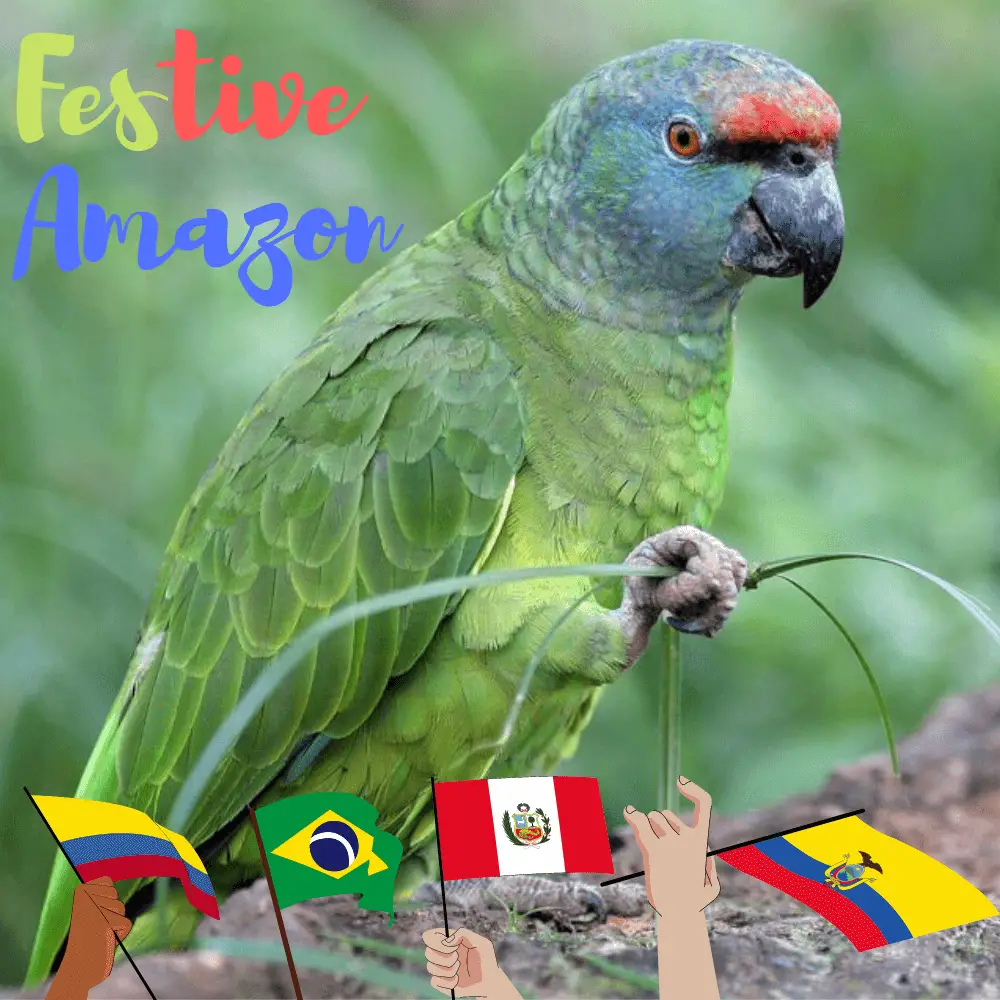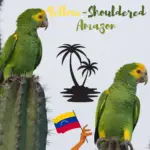
The festive parrot or Festive Amazon (Amazona festiva) is a medium-sized (about 34 cm) Amazon Parrot species.
Festive Amazon is found in Brazil, Colombia, Ecuador, Bolivia, Guyana, Peru, and Venezuela.
| Reign | Animal |
|---|---|
| Fork | Chordata |
| Sub-embr. | Vertebrate |
| Class | Poultry |
| Order | Psittaciformes |
| Family | Psittacidae |
| Gender | Amazon |
Description
Like most species of the genus, the festive parrot has predominantly green plumage. His neck is tinged with black. A narrow dark red frontal band extends on either side of the head of the beak attachment to the eyes while two more extensive azure blue spots adorn the back of the eyes. The cheeks are yellowish-green and the chin blue.
In adults, the cheeks and sides of the neck are green with strong infiltration of blue. The lores and the narrow frontal band are red. The feathers that are above and behind the eye have a bluish tint. The forehead is rather yellowish while the cap is a darker green. The feathers of the nape are also green but with a slightly darker terminal band. The scapulars, mantle, upper back, and supracaudal covers are dark green-pre. The rump and the majority of the lower back are scarlet red.
The primary covers are purplish-blue, and the rest of the covers are green. The carpal edge of the wing and the edges of the outer nets of the primary remiges have a blue tint. The inner nets are black. The secondary ones have blue ends and solid green inner nets.
The underside of the wings is entirely green. The chin and throat are blue, and the chest and belly are a paler green than the top. The subcaudals are greenish-yellow. The tail is green with a paler yellowish-green tip. Some infiltrations of red are visible on some rectrices. The beak is horn-brown, the irises yellow. The legs are grayish-black. The male and female are similar. Immature ones have a green rump and less blue on their head.
Voice
In-flight, festive Amazon emits a characteristic and nasal “bwahht, bwahh’t bwah’t” that resonates a bit like human laughter from a distance. When perched, they produce a greater variety of sounds, especially shrill cries that can be transcribed as follows: “scree-ee-at”. One can also hear giggles and joyful notes close to the human repertoire.
Subspecies
The Festive Amazon is represented by two subspecies:
- A. f. festiva widespread in eastern Ecuador, northeastern Peru, southeastern Colombia, and the eastern Amazon in Brazil;
- A. f. bodini widespread in northwestern Guyana and Venezuela in the regions bordering the Orinoco.
This subspecies differs from the typical form by a rather yellowish-green plumage, a larger extent of red frontal spots, and the presence of a bluish shade on the cheeks1.
Habitat
This species inhabits primary Amazonian-type forests and gallery forests along streams. festive parrot frequents lowland rainforests up to 500 meters above sea level. They generally prefer forests temporarily invaded by water (varzeas), marshy afforestation, or those located on islands. They also appreciate wooded areas along wide rivers and gallery forests, especially if they have not been degraded. Occasionally, they are also found in wet savannahs. These birds are always dependent on water and they avoid dry or arid forests (terra firm). In Brazil, they can climb up to 500 meters while in Venezuela they usually do not exceed 100 meters above sea level.
Character
festive parrots have a behavior very similar to that of other parrots of the genus Amazona. In the evening, these birds are very noisy, especially when individuals gather before joining the common dormitories. festive Amazon parrot usually lives in small flocks, but sometimes they can be seen in large gatherings of up to 50 individuals, as is the case from March to June near the city of Leticia in Colombia.
festive Amazon parrots are sedentary, yet they make movements that sometimes carry them beyond the normal limits of their range. They can be observed as far east as Ecuador, southwest Guyana and the Amazon Delta. However, these reports require confirmation.
Diet
No information. This species is assumed to be vegetarian and frugivorous.
Nesting reproduction
For most books dealing with parrots, the reproductive mores of this species are not known. In the wild, no information is provided on nesting sites, egg-laying size, and incubation time. According to the World Parrot Trust website, in captivity, the brood includes 3 eggs. According to the Handbook of the Birds of the World, these are incubated for 25 or 26 days. Like other birds of the genus Amazona, it is assumed that this species is a cave and nests in tree holes.
Distribution
Amazona festival is native to the north of the South American continent. They can be seen mainly in northwestern Brazil and Venezuela along major rivers such as the Amazon and Orinoco. Their range also covers northeastern Peru along the Rio Napo and Rio Ucayali. This species is divided into two distinct populations that correspond to two officially recognized breeds: A. f. boding (Orinoco River and its tributaries, Venezuela and southeastern Guyana) – A. f. Festiva (basin of the Amazon and its main tributaries, Rio Negro, Rio Tapajos, Rio Madeira, and Rio Purus, in Brazil, Peru and in the extreme east of Colombia and Ecuador).
Threats – Protection
festive amazon is not globally threatened. In Brazil, they are locally common because their habitat is quite well preserved. On the upper course of the Amazon, they are even relatively abundant. However, in Venezuela, this species suffers from both habitat disintegration and poaching for commercialization as a pet bird. These birds are indeed very popular with collectors because they are excellent talkers capable of imitating the human voice. According to Birdlife, the area of its territory is 857,000 square kilometers. The numbers are not quantified but they seem stable. The festive amazon is considered a bird that does not face major problems.
Festive Amazon video
SOURCE:paws4caws
Related Articles:




















